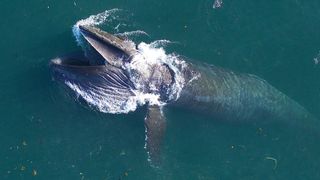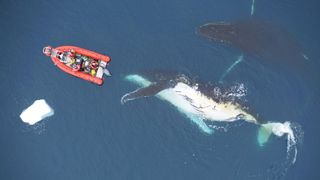Baleen whales eat three times more than scientists once thought

Earth's largest animals may eat even more gargantuan amounts of food than scientists thought, a new study reveals.
Baleen whales — which capture krill, fish, zooplankton and squid by filtering seawater through their special structures in their mouths — may consume up to three times more prey than previously estimated, the study found.
The discovery could rattle our understanding of how nutrients flow through ocean food webs. After feeding deep underwater, the whales swim upward to breathe and release impressive plumes of poop near the surface of the ocean. There, the iron-rich whale feces acts as a fertilizer for phytoplankton, microscopic organisms that draw energy from sunlight to conduct photosynthesis. The fertilized phytoplankton then get devoured by hungry krill, which then get eaten by whales, and so on.
Related: In photos: Tracking humpback whales
If you remove whales from this loop, the iron that would normally be distributed in their poop would instead settle to the ocean floor in krill feces and dead krill carcasses; in turn, this would deprive phytoplankton on the surface of the iron they need to thrive. This may help to explain why, after whalers killed off millions of baleen whales in the 20th century, krill populations within the whaling grounds declined dramatically, falling more than 80% in parts of the Southern Ocean, for example, the study authors wrote in the study, published Nov. 3 in the journal Nature.
"These animals are more important ecosystem engineers than we previously thought," in that they help boost the amount of fuel available to the entire ecosystem, said first author Matthew Savoca, a National Science Foundation postdoctoral research fellow at Stanford University's Hopkins Marine Station. By helping to conserve baleen whale populations today, we could help to restore the iron-recycling system once derailed by industrial whaling, he said.
Big eaters
Baleen whales get their name from the comb-like structures that grow from their upper jaws. The whales use these structures, made of keratin — the same protein that makes up human hair and fingernails — to filter-feed, either continuously, by swimming open-mouthed through dense throngs of prey, or sporadically, by suddenly lunging at their prey while taking in gigantic gulps of water. Right whales and bowhead whales take the former approach, while blue, fin, minke and humpback whales use the latter.
Sign up for the Live Science daily newsletter now
Get the world’s most fascinating discoveries delivered straight to your inbox.
Although scientists understand the basics of how baleen whales feed, estimating how much they eat has been difficult. Prior to the new study, Savoca was interested in how much plastic and other pollutants baleen whales might be ingesting. But to investigate that question, he had to dig into past research of how much prey the whales consume.
"To my great surprise … it had never been measured in living whales," Savoca told Live Science. In the past, scientists examined the stomach contents of dead whales to get an idea of how much they ate, but such studies couldn't say how much a given whale ate in a day, month or year. Researchers also developed models of how much food a whale would need to survive, but these models were based on the metabolic rates of other large marine animals, such as captive dolphins.
Given the lack of research on live baleen whales' feeding habits, Savoca and his collaborators decided to gather data straight from the whale's mouth (so to speak). "What these authors did is, they actually measured the amount of food eaten by the whales, by monitoring their feeding behavior," said Victor Smetacek, a professor at the Alfred Wegener Institute Helmholtz Centre for Polar and Marine Research in Germany who was not involved in the study.
Between 2010 and 2019, the team placed tags on 321 individual whales from seven baleen species, which lived in the Atlantic, Pacific and Southern oceans. Each tag, secured with a suction cup, was equipped with GPS, a camera, a microphone and an accelerometer, which recorded the whales' movements for about 5 to 20 hours, until the tag popped off.
Related: 15 of the largest animals of their kind on Earth

The tags tracked how each whale moved in 3D space and therefore revealed when they engaged in feeding behaviors, Savoca explained. The team also snapped drone photos of 105 whales, to determine their lengths, their body mass and the amount of water they could likely capture in one mouthful. To figure out how much prey might be in that mouthful of water, the team visited whale feeding sites in boats equipped with so-called echo sounders. Using sound waves, the echo sounders measured the size and density of groups of prey in the whales' feeding grounds.
With the tag recordings, drone photos and echo-sounder data in hand, the team could determine how much each whale ate in a day. An adult eastern North Pacific blue whale (Balaenoptera musculus) eats about 17.6 tons (16 metric tons) of krill per foraging day, for example, while the bowhead whale (Balaena mysticetus) eats about 6.6 tons (6 metric tons) of zooplankton. Baleen whales feed an estimated 80 to 150 days out of the year, so using these daily intake estimates, the team could get an idea of how much the whales put away in a single feeding season, Savoca said.
They found, overall, baleen whales eat much more than previous estimates suggested. For example, researchers thought that the krill-feeding baleen whales living in the California Current Ecosystem, between British Columbia and Mexico, gobble up about 2.2 million tons (2 million metric tons) of prey each year, but in actuality, these whales eat closer to 6.6 million tons (6 million metric tons) of prey annually.
"A hopeful story"
Having determined how much modern-day whales eat, the team wondered how much whales ate in the past, before industrial whaling severely depleted their numbers.
They used whaling industry records to address this question, and focused specifically on Southern Ocean lunge-feeding species, which again nab prey by suddenly charging at them. An estimated 1.5 million of the 2 million lunge-feeding whales killed in the 20th century were removed from the Southern Ocean, with the largest whales, like the blue whale, enduring the greatest losses, the authors noted.
The analysis suggests that, at the start of the 20th century, minke, humpback, fin and blue whales in the Southern Ocean likely consumed about 473.9 million tons (430 million metric tons) of krill each year. The loss of millions of whales between 1910 and 1970 likely contributed to the subsequent decline in krill, since the whales' poop once fertilized a major food source for the crustaceans, the authors suggest.
"What it implies is that these historic ecosystems … were 10-fold more productive than they are today," based on the amount of iron-rich poop whales would have produced prior to industrial whaling, Savoca said. And on top of the loss of the whales, climate change likely also drove the decline in krill, he noted. But by both conserving whale populations and addressing climate change, we could potentially regain some of the lost productivity in these ecosystems.
"I really do think there's a hopeful story here," he told Live Science. All the components of the system — the whales, krill and phytoplankton — are still there, albeit in smaller numbers. What the system really needs is a "jump start," Savoca said.
Jump-starting the system would involve boosting whale populations through a combination of passive conservation efforts, such as establishing new marine protected areas, and active conservation efforts, such as setting ship speed limits to prevent whales from being struck by boats. Regulations could also bar fishing boats from working when whales are in the area, to avoid entangling the animals in nets. And of course, in addition to these direct measures, broader efforts to rein in climate change would also help whales recover, Savoca said.
In theory, Smetacek said, scientists could jump-start the whale-krill system in another way: By purposefully fertilizing phytoplankton with iron, thus boosting the organisms' growth and, in turn, bolstering krill and whale populations. Essentially, the iron fertilizer would stand in for the missing whale poop.
This idea of seeding the oceans with iron has been raised in the past, as a way to increase the amount of carbon that phytoplankton pull from the atmosphere, Mongabay reported. But the idea remains controversial, in part due to a lack of studies on the potential large-scale ecosystem impacts that such fertilization might trigger. It's also not clear if the effort would boost fish and krill populations in the long term.
Originally published on Live Science.

Nicoletta Lanese is the health channel editor at Live Science and was previously a news editor and staff writer at the site. She holds a graduate certificate in science communication from UC Santa Cruz and degrees in neuroscience and dance from the University of Florida. Her work has appeared in The Scientist, Science News, the Mercury News, Mongabay and Stanford Medicine Magazine, among other outlets. Based in NYC, she also remains heavily involved in dance and performs in local choreographers' work.
